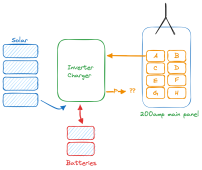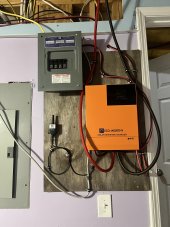inowhavesolar
New Member
- Joined
- Jun 15, 2022
- Messages
- 14
Hello. Newbie here. I'm having a hard time understanding how a grid-tied inverter setup works without completely rewiring my main breaker panel. Here is my rudimentary diagram. My electric company does not do credits for surplus. Still, as I understand it, a grid-tied system can "slow down" the meter spin and use the solar power first. But again, how does "solar power" get priority if everything is in one breaker box?

I have a 200 amp mains panel. Breakers B-H go to various things around the house. From the videos I've watched, I would use breaker A to output A/C to the inverter. I would also connect the solar panels, and batteries to the inverter. The inverter would output A/C from solar/batteries onto line P. If there isn't enough solar, or batteries are low, the inverter will "top up" any demand using mains. Am I correct so far?
So, where does wire 'P' connect? This is the inverter A/C output, coming from solar/batteries/mains. Do I add another breaker 'J' into the main panel and wire in the inverter output there? Doesn't that create a loop? How do breakers B-H know to use the power coming from line P vs coming from mains? It seems like I would have to add a new panel, relocate breakers B-H to it plus J. The main panel would then only have incoming grid and breaker A to the inverter. The subpanel would have incoming A/C breaker J from the inverter, and breakers B-H for everything else in the house. But I haven't really seen anyone do this in their setups.

I have a 200 amp mains panel. Breakers B-H go to various things around the house. From the videos I've watched, I would use breaker A to output A/C to the inverter. I would also connect the solar panels, and batteries to the inverter. The inverter would output A/C from solar/batteries onto line P. If there isn't enough solar, or batteries are low, the inverter will "top up" any demand using mains. Am I correct so far?
So, where does wire 'P' connect? This is the inverter A/C output, coming from solar/batteries/mains. Do I add another breaker 'J' into the main panel and wire in the inverter output there? Doesn't that create a loop? How do breakers B-H know to use the power coming from line P vs coming from mains? It seems like I would have to add a new panel, relocate breakers B-H to it plus J. The main panel would then only have incoming grid and breaker A to the inverter. The subpanel would have incoming A/C breaker J from the inverter, and breakers B-H for everything else in the house. But I haven't really seen anyone do this in their setups.



